Understanding Your UK Driving Licence
If you’re planning to drive overseas with your UK licence, it’s essential to understand the type of licence you hold and how it is recognised abroad. In the UK, there are two main types of driving licences: the photocard licence and the older paper counterpart. The photocard licence has been standard since 1998 and features your photograph, signature, and important personal details, while the paper licence was issued prior to this date and does not include a photo.
| Type of Licence | Issued From | Key Features | International Recognition |
|---|---|---|---|
| Photocard Licence | 1998 onwards | Contains photo, signature, expiry date, address | Widely accepted in most countries* |
| Paper Licence | Before 1998 | No photo or signature; basic information only | Acceptance varies; may need additional ID or an International Driving Permit (IDP) |
*While most European countries and many others recognise the UK photocard licence, some destinations require an IDP regardless of which type you hold. It’s always worth checking specific requirements before travelling.
Your UK driving licence serves as proof of your ability to drive, but keep in mind that rules on recognition can differ depending on where you’re headed. For smoother journeys abroad, understanding these distinctions will help you prepare all necessary documentation and avoid unexpected issues at car hire desks or roadside checks.
2. International Driving Permit (IDP): When and Why You Need It
If you’re planning to drive outside the UK, it’s crucial to check whether you’ll need an International Driving Permit (IDP) in addition to your UK driving licence. Not every country requires one, but for some destinations, it’s a legal must-have for hiring or driving a vehicle. Here’s what you need to know to stay compliant and avoid any unwelcome surprises abroad.
When is an IDP Required?
An IDP acts as an official translation of your UK driving licence and is recognised by many countries worldwide. Whether you need one depends on your destination and the length of your stay. For instance, most EU countries don’t require an IDP for short visits if you hold a photocard driving licence, but several non-EU countries do—especially if your stay exceeds a certain period or your licence is paper-only.
Where to Get an IDP in the UK
You can obtain an IDP easily from most Post Office branches across the UK. It usually costs just £5.50, and you’ll need to bring along your full, valid UK driving licence, a passport-sized photo, and proof of identification. The process is straightforward and often completed on the spot.
Which Countries Recognise or Require an IDP?
The requirements vary widely, so always check before you travel. Here’s a quick guide to popular destinations:
| Country | IDP Required? | Notes |
|---|---|---|
| France | No (for short stays) | Photocard licences accepted; longer stays may differ |
| USA | Recommended/Required in some states | Especially important if hiring a car |
| Japan | Yes | IDP mandatory for visitors |
| Australia | Varies by state | Generally needed with non-English licences |
| UAE | Yes | IDP required alongside UK licence |
| Canada | No (in most provinces) | Some rental companies may ask for one |
| Turkey | Yes (if staying over 6 months) | IDP recommended regardless of length of stay |
Top Tips Before You Travel
– Always double-check the latest rules with the embassy or consulate of your destination country.
– Carry both your UK licence and IDP at all times when driving overseas.
– Remember, IDPs are only valid for one year, so plan accordingly if you’re a frequent traveller.
![]()
3. Travel Insurance and Vehicle Documents
When taking your UK licence on the road abroad, its crucial to carry more than just your photocard. Having the right documents at hand can save you from unnecessary stress and ensure youre legally covered in case of any incidents. Here’s what you need to know about travel insurance, vehicle paperwork, and breakdown cover when driving overseas.
Essential Documents Checklist
| Document | Purpose | Notes |
|---|---|---|
| Travel Insurance | Covers medical emergencies, personal belongings, and sometimes accidents involving hire vehicles | Ensure it covers driving or hiring a car abroad; check excess and exclusions |
| V5C Logbook (Vehicle Registration) | Proves legal ownership of your vehicle | You must carry the original V5C, not a copy; necessary for border checks and police stops |
| Valid Motor Insurance Certificate | Covers damage or injury while driving overseas | Contact your insurer for a Green Card if required by the country you’re visiting |
| Breakdown Cover Policy | Assistance in case of mechanical failure or accident | Check if your UK policy extends to Europe; consider European breakdown cover for peace of mind |
Why Carry These Documents?
If you’re stopped by local authorities abroad, you’ll likely be asked to produce your insurance certificate and V5C logbook as proof that your car is properly insured and registered. Failing to provide these can result in fines, vehicle impoundment, or even being denied entry into certain countries.
Top Tips for UK Drivers Abroad
- Keep all documents together in an easy-to-reach folder inside your vehicle.
- If you’re hiring a car, double-check that insurance documents are included with the rental agreement.
- If travelling through several countries, make sure each one recognises your insurance and registration – requirements can vary.
Summary Table: What You Need When Driving Overseas with Your UK Licence
| Requirement | UK Licence Holder Driving Own Car Abroad | UK Licence Holder Hiring a Car Abroad |
|---|---|---|
| Photocard Driving Licence | Yes | Yes |
| V5C Logbook | Yes (original) | No (rental company provides vehicle docs) |
| Insurance Certificate / Green Card | Yes (check requirements per country) | No (rental company covers this) |
| Breakdown Cover Details | Recommended | N/A (check rental T&Cs) |
4. Visa, Passport, and Identification Essentials
When you’re driving overseas with your UK licence, it’s crucial to have the right identification documents in order. Always ensure your passport is valid for the entire duration of your trip—many countries require at least six months’ validity beyond your planned return date. Don’t forget to check if you need a visa for the country or countries you’ll be visiting, especially if you’re planning to cross borders within Europe or further afield.
Passport Validity and Visa Requirements
| Country/Region | Passport Validity Needed | Visa Required? | Additional Notes |
|---|---|---|---|
| EU/EEA (post-Brexit) | At least 6 months | No for short visits (up to 90 days in any 180-day period) | Check Schengen rules for longer stays |
| USA | At least 6 months | ESTA required for most UK travellers | Apply online before travel |
| Australia | At least 6 months | eVisitor visa required | Apply online before travel |
| Japan | Valid for duration of stay | No visa for short visits (up to 90 days) | |
| UAE | At least 6 months | Visa on arrival (for UK passport holders) |
Recommended Forms of ID While Driving Abroad
Apart from your passport and visa (if needed), it’s wise to carry an additional form of photo identification. Many car hire companies or local police checks may ask for this. Here are some recommended forms:
- Your UK photocard driving licence: Always bring both the photocard and the paper counterpart if you have one.
- An International Driving Permit (IDP): Some non-EU countries require this alongside your UK licence.
- A second form of ID: Such as a National Identity Card (if you have one) or another government-issued card.
- A copy of your passport: Keep a photocopy or digital copy separate from your main documents in case of loss or theft.
Top Tips for Staying Organised on the Road
- Double-check entry requirements: Use official government websites for up-to-date information before you travel.
- Keep documents accessible but secure: Don’t leave them unattended in vehicles; use hotel safes where possible.
- Email copies to yourself: This makes retrieval easier if anything goes missing while abroad.
- If travelling across multiple countries, research each country’s specific rules: Passport validity, visa requirements, and accepted IDs can vary widely.
A little preparation goes a long way: making sure all your documents are in order will help you avoid unnecessary stress and enjoy your journey behind the wheel abroad.
5. Local Road Rules and Additional Permits
Before hitting the road abroad with your UK driving licence, it’s crucial to familiarise yourself with local road rules and any extra permits or documentation required in your destination country. Requirements can vary widely across Europe and beyond, so a little research goes a long way in avoiding fines or travel hiccups.
Toll Stickers & Vignettes: Many European countries require drivers to display a toll sticker (also called a vignette) on their windscreen for motorway use. These are often available at border crossings, petrol stations, or online before you travel.
Environmental Badges: Some cities, especially in Germany, France, and Italy, have low emission zones where only vehicles displaying an environmental badge are allowed. Failing to have the correct badge can result in hefty penalties.
City Permits: In certain urban areas, such as Milan or London’s Ultra Low Emission Zone (ULEZ), you might need a special permit to enter or drive within city limits. Always check if your car meets the requirements and arrange any necessary permits ahead of time.
Quick Reference Table: Common Overseas Driving Requirements
| Country | Toll Sticker Needed? | Environmental Badge? | City Permit Required? |
|---|---|---|---|
| Austria | Yes (Vignette) | No | No |
| France | Tolls on Motorways (pay as you go) | Certain Cities (Crit’Air badge) | Some cities |
| Germany | No for motorways | Certain Cities (Umweltplakette) | No |
| Italy | Tolls on Motorways (pay as you go) | Certain Cities (Eco Pass) | ZTL zones in cities |
Top Tips for UK Drivers:
- Always check the official government or tourist board websites of your destination for up-to-date requirements.
- If hiring a car, ask your rental company about local permits—they may be able to provide them directly.
- Keep all physical permits visible in your vehicle as required by law.
Summary:
A bit of homework can save you money and stress when driving overseas. Take time to research each country’s specific requirements regarding tolls, environmental badges, and city access permits before you set off with your UK licence.
6. Practical Tips for Document Safety and Accessibility
When you’re driving abroad with your UK licence, keeping your essential documents safe and accessible is crucial. Whether you’re on a city break or a cross-country road trip, a bit of planning will help you avoid stress if you’re stopped by the police or need to present documents at a car hire desk. Here’s some everyday advice to keep you covered.
Keep Originals Safe, Carry Copies
It’s wise to store original documents such as your driving licence, passport, and insurance paperwork in a secure location—ideally a locked glove compartment or hotel safe. For daily driving, carry high-quality photocopies. Digital scans saved securely on your phone or cloud storage can also be handy, but remember that some authorities may still request to see physical copies.
Be Prepared for Roadside Checks
Different countries have different requirements when it comes to roadside checks. In some places, police can ask for your documents at any time. Being organised avoids unnecessary hassle and delays. Here’s a quick reference table to help you prepare:
| Document | Where to Keep Original | Carry Copy? |
|---|---|---|
| UK Driving Licence | Locked glovebox or hotel safe | Yes, both paper and digital if possible |
| Passport | Hotel safe (unless required by law) | Yes, especially digital copy |
| Insurance Certificate | Secure folder in car/hotel | Yes |
| IDP (if needed) | Together with licence | Yes |
Stay Organised on the Road
- Use an organiser pouch for all travel documents.
- Label folders clearly so you’re not rummaging around if stopped.
- If travelling with others, make sure everyone knows where the documents are kept.
If Documents Go Missing
If you lose any essential document while abroad, contact the local British embassy or consulate immediately. Having digital backups and copies will speed up replacement processes and keep your journey running smoothly.
A Final Word of Advice
The key is preparation: don’t leave things until the last minute. With a bit of forethought, you’ll drive with peace of mind—ready for whatever comes your way on foreign roads.


